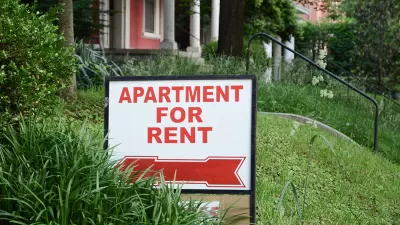The common metric for measuring housing affordability—whether households pay more than 30 percent of their income on shelter—has its downsides. Looking at residual income offers more precision in some respects.

A working paper from Harvard's Joint Center for Housing Studies examines housing affordability on the basis on residual income, a metric that's more sensitive to demographic differences in circumstance than the usual 30-percent standard. Chris Herbert and Daniel McCue write, "This alternative approach improves on the simple 30-percent standard by estimating the cost of 'everything else' as a function of the number and ages of all household members. It then estimates how much income would be available to pay for housing if those other costs were fully covered."
"In this framework," they go on, "the share of income that can be devoted to housing is not a single standard, but rather varies depending on both the size and composition of the household and the level of household income." That means a well-paid young professional may be devoting 50 percent of his or her income to rent, but still have more than enough for necessary and discretionary expenses, even in a high-cost city. The same would likely not be the case for someone earning low wages, or for a household with lots of kids.
The paper finds that compared to the residual income measure, the 30-percent standard often overstates affordability problems in high-cost markets, for high-income and smaller households. But overall levels of affordability remain similar in both models.
In a Slate article expanding on the topic, Henry Grabar writes that the 30-percent model "can't tell the difference between places where rents are growing too fast and those where incomes are growing too slowly—making it hard to tell if the problem is a housing shortage or the more entrenched issue of poverty and low wages."
FULL STORY: Is There a Better Way to Measure Housing Affordability?

Alabama: Trump Terminates Settlements for Black Communities Harmed By Raw Sewage
Trump deemed the landmark civil rights agreement “illegal DEI and environmental justice policy.”

Planetizen Federal Action Tracker
A weekly monitor of how Trump’s orders and actions are impacting planners and planning in America.

The 120 Year Old Tiny Home Villages That Sheltered San Francisco’s Earthquake Refugees
More than a century ago, San Francisco mobilized to house thousands of residents displaced by the 1906 earthquake. Could their strategy offer a model for the present?

Ken Jennings Launches Transit Web Series
The Jeopardy champ wants you to ride public transit.

BLM To Rescind Public Lands Rule
The change will downgrade conservation, once again putting federal land at risk for mining and other extractive uses.

Indy Neighborhood Group Builds Temporary Multi-Use Path
Community members, aided in part by funding from the city, repurposed a vehicle lane to create a protected bike and pedestrian path for the summer season.
Urban Design for Planners 1: Software Tools
This six-course series explores essential urban design concepts using open source software and equips planners with the tools they need to participate fully in the urban design process.
Planning for Universal Design
Learn the tools for implementing Universal Design in planning regulations.
Clanton & Associates, Inc.
Jessamine County Fiscal Court
Institute for Housing and Urban Development Studies (IHS)
City of Grandview
Harvard GSD Executive Education
Toledo-Lucas County Plan Commissions
Salt Lake City
NYU Wagner Graduate School of Public Service





























